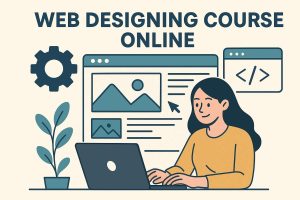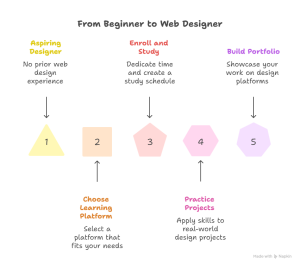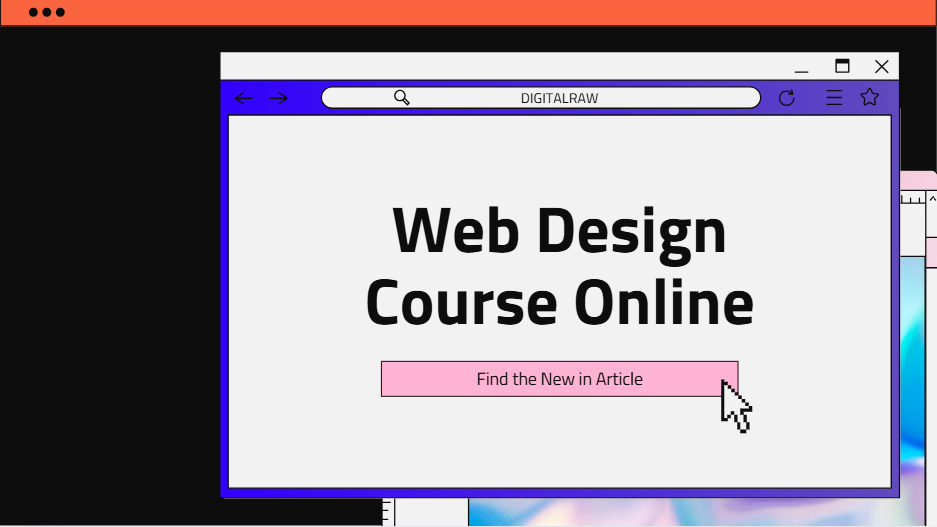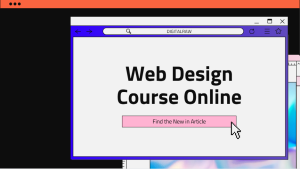Best Web Design Course Online in 2025: Master Website Design Like a Pro
Introduction: Why Learning Web Design Online Is a Game-Changer
In today’s digital-first world, businesses, creators, and professionals are constantly seeking visually appealing and user-friendly websites. This makes web design one of the most valuable skills in the tech industry. With the rise of e-learning, enrolling in a web design course online has become the fastest and most flexible way to enter this thriving field.

Unlike traditional education, online learning allows you to study from anywhere, learn at your own pace, and apply skills in real-time projects. Whether you’re a beginner with zero coding experience or a creative looking to expand your digital skillset, an online web design course offers an affordable and effective path to success.
What Is a Web Design Course Online?

Defining Online Web Design Training
A web design course online teaches you how to plan, design, and build modern websites using various tools and technologies. Most programs combine visual design principles, front-end development skills, and user experience (UX) concepts.
You’ll learn how to use HTML and CSS to structure and style web pages, integrate interactivity with JavaScript, and create responsive designs that look great on all devices.
Key Components of a Web Design Curriculum
The best Web Designing Course Online programs offer a mix of:
- Theory and practice: Understanding design theory, color psychology, and typography.
- Technical mastery: Coding, responsive layouts, and accessibility standards.
- Project-based learning: Building real-world websites from scratch.
- Career readiness: Portfolios, client communication, and freelancing strategies.
Benefits of Taking a Web Design Course Online
Learn at Your Own Pace and Schedule
Web Design Course Online provide unmatched flexibility. You can watch lessons anytime, pause and review concepts, and learn according to your schedule—perfect for working professionals or students managing multiple commitments.
Affordable and Accessible Learning for Everyone
Compared to traditional design schools, online courses are budget-friendly and globally accessible. Platforms like Coursera, Udemy, and edX offer free trials or low-cost subscriptions, making it easy for anyone to start learning web design.
Practical, Hands-On Training from Experts
The top web design course online programs feature industry professionals as instructors who share insider tips, real-world examples, and best practices. You’ll gain the practical experience employers value most.
Essential Skills You’ll Learn in a Web Design Course Online
HTML, CSS, and JavaScript Foundations
Web Design Course Online. These are the core building blocks of the web. HTML structures the content, CSS adds style and layout, while JavaScript makes your pages interactive and dynamic. Mastering these languages sets the foundation for all future web design work.
Responsive Design and UX/UI Principles
Web Design Course Online A well-designed website adapts seamlessly to different screen sizes. Courses teach how to create responsive websites using CSS frameworks like Bootstrap, while also introducing user-centered design principles to improve usability and satisfaction.
Web Tools and Frameworks: Adobe XD, Figma, and WordPress
Modern designers rely on tools like Figma for prototyping, Adobe XD for mockups, and WordPress for content management. A complete web design course covers these platforms to ensure you’re ready for real-world design projects.
Top 5 Accredited Web Design Courses Online in 2025
1. DigitalRaw Academy – Google UX Design Professional Certificate
An industry-recognized course designed by Google, focusing on UX fundamentals, wireframing, and usability testing. Includes portfolio projects.
2. Udemy – The Complete Web Design Course
Covers HTML, CSS, JavaScript, jQuery, and responsive design with practical projects—ideal for beginners.
3. Skillshare – Responsive Web Design Masterclass
A short yet intensive course emphasizing flexible layouts and accessibility standards.
4. LinkedIn Learning – Web Design for Beginners
Perfect for absolute beginners, offering guided tutorials on essential tools and workflows.
5. edX – Web Design and Development by W3C
Endorsed by the World Wide Web Consortium (W3C), this course ensures deep technical and standards-based understanding.
How to Choose the Right Web Design Course Online for You
With hundreds of online learning platforms available, finding the best web design course online can feel overwhelming. The key is to choose one that matches your learning goals, career ambitions, and skill level.
Consider Your Learning Goals and Career Path
If you want to become a professional web designer, focus on a comprehensive course that covers both design theory and front-end development.
If your goal is to create websites for personal projects or clients, shorter courses on WordPress or responsive design might be perfect.
Check Web Design Course Online Content, Duration, and Reviews
Before enrolling, carefully examine:
- The curriculum: Does it include practical assignments and real-world projects?
- The duration: Can you complete it at your own pace?
- The reviews: Are students satisfied with the teaching style and outcomes?
User feedback can be a reliable indicator of course quality.
Evaluate Certificates and Industry Recognition
Many learners overlook this, but the certificate’s credibility can boost your resume. Courses endorsed by Google, Adobe, or W3C hold significant industry weight, especially when applying for freelance or full-time positions.

Step-by-Step Guide to Starting Your Web Design Journey Online
Getting started is easier than ever. Here’s a clear path to follow when enrolling in a web design course online:
Step 1: Identify Your Learning Platform
Choose a platform that aligns with your needs—DigitalRaw for structured programs, Udemy for flexible learning, or Skillshare for creative-focused lessons.
Step 2: Enroll and Set a Study Schedule
Discipline is key. Dedicate a few hours weekly and create a consistent schedule to stay on track. Consistency leads to faster progress and better retention.
Step 3: Practice with Real Projects
Theory alone won’t make you a designer. Apply your new skills by designing mock websites, landing pages, or even nonprofit projects.
Step 4: Build a Personal Web Design Portfolio
Your portfolio is your biggest asset. Include screenshots, live website links, and project summaries. Platforms like Behance or Dribbble are excellent places to showcase your work.
Common Mistakes to Avoid When Learning Web Design Online
Ignoring Fundamentals and Jumping to Frameworks
Many beginners skip HTML and CSS basics, diving straight into frameworks like Bootstrap or React. However, without a solid foundation, advanced concepts can feel confusing later.
Not Practicing Consistently
Design is a hands-on skill—you learn by doing. Make it a habit to design something every week, even if it’s a small project.
Skipping Feedback and Peer Review Opportunities
Sharing your work with online communities helps you grow faster. Constructive criticism from peers or mentors reveals blind spots and improves your design sense.
Career Opportunities After Completing a Web Design Course Online
Once you complete your course, a world of exciting career options opens up.
Becoming a Freelance Web Designer
Freelancing gives you freedom and flexibility. You can work with global clients, set your rates, and build a diverse portfolio of projects.
Joining a Web Development Agency
Agencies offer teamwork, mentorship, and exposure to large-scale projects. This is ideal if you want to gain professional experience and work with established brands.
Building Your Own Web Design Business
Many successful designers turn entrepreneurship into their next step—offering branding, design, and website creation services for local and online businesses.
Estimated Salary and Growth Potential in Web Design Careers
According to global industry reports (as of 2025):
- Entry-level web designers earn between $40,000–$60,000 per year.
- Mid-level professionals average $65,000–$85,000, depending on experience and skills.
- Freelancers often charge $30–$100 per hour, depending on project complexity.
As businesses continue to expand their digital presence, demand for skilled designers will grow by 23% over the next five years, making this an excellent long-term career.
Tools and Resources for Aspiring Web Designers
Design Inspiration Websites and Communities
Stay inspired by exploring platforms like:
- Awwwards – Showcasing the best modern web designs.
- Behance – A hub for creative professionals to share portfolios.
- Dribbble – Focused on visual and UI design inspiration.
Free Coding and Design Resources
- FreeCodeCamp.org – Learn HTML, CSS, and JavaScript through interactive exercises.
- Canva’s Design School – For visual design basics.
- W3Schools – A free coding resource for web technologies.
Can I Learn Web Design in 3 Months? The Honest Truth for Beginners
Is It Really Possible to Learn Web Design in 3 Months?
If you’ve ever dreamed of creating beautiful, responsive websites but wondered, “Can I learn web design in 3 months?”, the short answer is yes — with the right plan, discipline, and resources, it’s absolutely achievable.
Web design is a combination of creative and technical skills. You’ll learn how to make websites not only look great but also function smoothly across devices. And the good news? Thanks to modern online learning platforms, you can now gain these skills faster than ever before — even if you’re starting from zero.
In this guide, you’ll discover exactly what to learn, how to structure your time, and which tools to use to master web design in 3 months and confidently build your first professional portfolio.
Understanding What Web Design Involves
Before diving into your 3-month roadmap, it’s crucial to understand what web design truly entails.
Difference Between Web Design and Web Development
Many beginners confuse web design with web development.
- Web design focuses on the visual appearance, user experience (UX), and layout of a website.
- Web development, on the other hand, involves the coding that brings those designs to life.
While designers need to understand basic coding languages like HTML and CSS, their main goal is to craft user-friendly, visually pleasing websites.
The Core Skills You Need to Learn
To become proficient in web design, you’ll need to master:
- HTML (Hypertext Markup Language): For structuring web pages.
- CSS (Cascading Style Sheets): For styling and layout.
- JavaScript: For interactivity.
- Design Principles: Color theory, typography, and layout balance.
- UX/UI: Understanding how users interact with digital spaces.
The 3-Month Web Design Learning Roadmap
The secret to mastering web design in three months is a structured and realistic learning plan. Here’s what your journey should look like:
Month 1: Learning the Basics – HTML, CSS, and Design Principles
Focus entirely on the foundations:
- Learn HTML5 structure and semantic tags.
- Master CSS3 styling, positioning, and responsive design basics.
- Understand color psychology, typography, and layout grid systems.
- Build simple static pages and practice daily.
Month 2: Intermediate Skills – JavaScript, Responsive Design, and UX
Once you’re comfortable with the basics, level up:
- Learn JavaScript fundamentals to add dynamic behavior to your pages.
- Dive deeper into responsive design using media queries and frameworks like Bootstrap.
- Study user experience (UX) principles: navigation, accessibility, and usability.
- Recreate existing websites to refine your skills.
Month 3: Building Projects and Creating a Portfolio
Now it’s time to apply everything you’ve learned:
- Create at least 3–5 real projects — landing pages, blogs, or small business sites.
- Design a personal portfolio website to showcase your skills.
- Learn the basics of SEO and website optimization.
- Start networking or applying for internships/freelance gigs.
Recommended Tools and Resources for Fast Learning
Best Online Platforms to Learn Web Design Quickly
- freeCodeCamp.org – Comprehensive and free coding tutorials.
- Coursera – Offers professional certificates from Google and Meta.
- Udemy – Affordable, project-based learning for beginners.
- Skillshare – Great for visual design and creative projects.
Essential Software and Design Tools
- Figma or Adobe XD for prototyping.
- VS Code for writing and testing code.
- Canva for learning visual design principles.
- Chrome DevTools for debugging and experimenting with layouts.
How to Structure Your Daily Learning Schedule
1 Hour per Day Study Plan (For Busy Learners)
If you have a full-time job or school:
- Weekdays: Spend 1 hour learning and 30 minutes practicing.
- Weekends: Dedicate 3–4 hours to projects.
By the end of 3 months, you’ll have a solid understanding of web design fundamentals.
3–4 Hours per Day Intensive Plan (For Career Switchers)
If you’re aiming to switch careers quickly:
- Morning: Study theory and watch tutorials.
- Afternoon: Practice hands-on projects.
- Evening: Join forums, take quizzes, and review concepts.
This plan helps you build real-world skills fast.
Common Challenges When Learning Web Design in 3 Months
Overwhelm and Information Overload
Web design has many moving parts. To stay focused, avoid learning everything at once — stick to your 3-month roadmap.
Struggling With Consistency
Learning daily, even for 30 minutes, is far more effective than binge-learning once a week. Consistency compounds progress.
Balancing Theory and Practice
Don’t just watch tutorials — build. The best way to learn design is by designing.
How to Stay Motivated and On Track
Learning web design in three months demands consistency and motivation. It’s easy to get discouraged midway, especially when certain topics feel too technical. The key is to stay organized, track your growth, and remember why you started.
Setting Realistic Goals and Milestones
Break down your 3-month learning plan into weekly milestones.
For example:
- Week 1–2: Learn HTML basics and build your first page.
- Week 3–4: Style your project with CSS.
- Week 5–6: Add interactivity with JavaScript.
- Week 7–8: Practice responsive design.
- Week 9–12: Build your final projects and portfolio.
Setting these small, achievable goals creates a sense of progress and keeps you motivated throughout your journey.
Finding a Mentor or Learning Community for web design course online
Having guidance accelerates your learning curve. Join web design groups on Reddit, Discord, or Facebook. Participate in online forums like Stack Overflow or Dev.to, where you can ask questions and share your progress. A mentor can also help you avoid common beginner mistakes.
Tracking Your Progress and Celebrating Wins on web design course online
Document your progress weekly. Keep a simple digital journal or social media thread showcasing what you’ve learned. Celebrating milestones—like building your first website or completing a mini-project—helps maintain enthusiasm.
Can You Get a Job After Learning Web Design in 3 Months? | web design course online
This is one of the most common questions students ask, and the answer is yes — but with conditions.
You can become job-ready in 3 months if you:
- Follow a focused curriculum
- Build real projects
- Develop a professional portfolio
However, mastering web design is an ongoing process. You’ll continue learning and improving long after your initial three months.
Entry-Level Job Opportunities | web design course online
After 3 months, you can pursue:
- Junior Web Designer positions
- UI/UX Assistant roles
- Website Maintenance Internships
Employers mainly look for your portfolio and problem-solving ability, not just certificates.
Freelance and Project-Based Work
Freelancing is an excellent way to gain experience quickly. Start small—offering affordable website design services to local businesses, startups, or nonprofits. Websites like Upwork, Fiverr, and Toptal connect you with real clients.
Internships and Remote Gigs
Many online platforms and digital agencies offer remote internships where beginners can learn while contributing to real-world projects. This is a great way to transition into full-time opportunities later.
Real Success Stories: Learners Who Did It in 3 Months | web Design Course online
Thousands of people worldwide have learned web design in just a few months.
- Sarah from London, a marketing graduate, learned HTML, CSS, and Figma in three months and now works as a freelance web designer.
- James from Canada completed a 12-week bootcamp on Udemy and landed an internship at a digital agency.
- Priya from India, a self-taught learner, built five portfolio websites in 90 days and now manages freelance projects for local clients.
Their secret? Consistency, curiosity, and commitment.
Tips to Accelerate Your Learning Curve
If you want to fast-track your progress, follow these proven strategies:
Focus on Real Projects Early On
Avoid getting stuck in endless tutorials. Apply what you learn by building real websites, even if they’re small. This reinforces learning and helps you retain information faster.
Learn from Industry Professionals
Enroll in courses led by experienced designers. They share insights from real client projects and teach you best practices that textbooks can’t cover.
Join Design Challenges or Hackathons
Participating in 30-day challenges or hackathons pushes you to learn quickly. You’ll get feedback, meet other learners, and experience the creative process in a collaborative environment.
FAQs About Learning Web Design in 3 Months
1. Is 3 months really enough to learn web design?
Yes! You can learn the fundamentals—HTML, CSS, and responsive design—in 3 months. However, mastering advanced skills will take more time and practice.
2. What skills should I focus on first?
Start with HTML and CSS, then move on to JavaScript and UX/UI design. Avoid jumping into complex frameworks too early.
3. Do I need a degree to become a web designer?
No. Most successful designers are self-taught. Employers value your portfolio more than formal education.
4. How much should I practice daily?
At least 1–2 hours per day of hands-on practice is ideal. If you’re aiming for a career switch, aim for 3–4 hours daily.
5. What’s the fastest way to build a portfolio?
Start by redesigning existing websites, creating fictional business sites, or completing client-based projects. Showcase them on Behance or your personal domain.
6. Can I start freelancing after 3 months?
Absolutely! Once you’ve built 3–5 projects and a strong portfolio, you can begin offering services on freelancing platforms.
7. How long does it take to complete a web design course online?
Most beginner-friendly courses take 3 to 6 months, depending on your pace. Intensive bootcamps can be completed in a few weeks.
8. Do I need prior coding knowledge to start learning web design?
No, most online web design courses start from scratch, covering HTML, CSS, and visual design concepts step by step.
9. Which platform offers the best certification for web design?
Coursera, edX, and Google Career Certificates are among the most recognized globally.
10. Can I get a job after completing an online web design course?
Yes! Many students land remote design jobs, freelance projects, or even launch their own agencies after completing certified programs.
11. What software will I learn in these courses?
You’ll typically learn Adobe XD, Figma, WordPress, and Photoshop, along with coding tools like VS Code.
12. Are free web design courses worth it?
Absolutely! Free courses are great for beginners to test the waters, but investing in a paid, structured course provides deeper learning and recognized certification.
Conclusion: Yes, You Can Learn Web Design in 3 Months—Here’s How to Make It Happen
So, can you learn web design course online in 3 months? Definitely—if you commit to consistent practice, structured learning, and real-world projects.
In just 90 days, you can build the foundational skills needed to design professional, responsive websites and even launch your freelance career. The journey doesn’t end there—keep learning new tools, exploring design trends, and refining your craft.
Remember: web design is a creative skill that rewards persistence and curiosity. Start today, stay consistent, and in three months, you’ll be amazed by how far you’ve come.








